
Canon EOS 5D Review
by Philip Greenspun; created September 2006
Site Home : Photography : EOS 5D
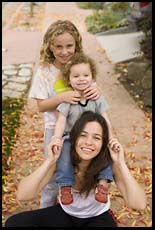
The 13-megapixel Canon EOS 5D single-lens reflex digital camera is the first consumer-priced ($2700) full-frame sensor body. It does just about everything that a $7000 EOS 1Ds body from 2004 did at about half the weight (2 lbs).
The primary advantages of having a digital sensor the same size (24x36mm) as a frame of 35mm film are (1) higher image quality, especially in terms of noise and especially in lower light situations, and (2) the ability to use very wide angle lenses. The only disadvantage to having a full-frame sensor compared to a small-sensor digital SLR body (Canon Digital Rebel or any Nikon) is that the small-sensor effectively increases the magnification of telephoto lenses, which can be useful when you are doing sports or bird photography. Of course, the resolution of the 5D is so high that you could pull out the central 8 MP of a Canon EOS 5D image and it would be almost as though you had taken the photo with a Canon 30D or Digital Rebel.
If you are a wide-angle junkie and have a bunch of older Canon EOS lenses designed for film cameras, you'll love having the EOS 5D. The small sensor Canon bodies turn an exciting 20mm wide angle lens into a boring 30mm perspective. With the 5D, what you got with your 20mm lens on the film camera is what you get with the 5D.
The Canon EOS 5D is compact and plasticky, but solidly built. Though noisier than a point-and-shoot digital camera, the Canon EOS 5D is extremely quiet in operation, quieter than any modern film body and with a slightly more muted and lower frequency shutter "thunk" than the small sensor Canon bodies.
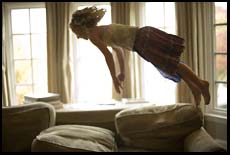
The Canon EOS 5D turns on almost instantly and has unmeasureable delays for taking pictures, displaying previews, and waking up once asleep. The camera is always ready when you are. The only exception to this rule is if you try to take pictures continuously at a rate that exceeds three photos per second. I.e., sports photographers might want to consider one of the EOS 1D bodies specifically designed for their rapid-fire needs.
Canon's EOS 5D has the standard four exposure modes: Metered Manual, Aperture-priority, Shutter-priority, and Program autoexposure. There are two control wheels so that you can adjust aperture and shutter speed simultaneously.
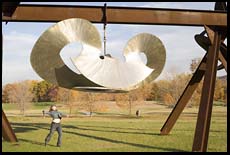
The 5D has the standard focus modes of any Canon SLR: Manual, Single-shot auto, Continuous auto, and "AI focus" where the camera tries to figure out whether or not your subject is moving. As with all of the great Canon EOS bodies over the decades, if you drill down into the custom function menus, you can figure out how to make the autoexposure lock button on the back of the camera into a "burst of AF" thumb switch while in Manual Focus mode. Thus you're able to manually adjust focus but have automatic assistance available when desired. Autofocus performance is superb, even in dim light, with 15 AF sensors distributed around the frame.
Sensitivity is adjustable from ISO 50-3200 but there is no good reminder of what you've got set and the setting is persistent if you turn the camera off and back on overnight.
Operation is modeless. If you've pressed the playback button and are reviewing images, a quick touch of the shutter release readies the camera to take pictures again.
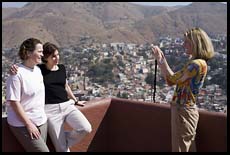
Viewfinder coverage on the Canon EOS 5D is standard for an advanced amateur single-lens reflex camera, about 96 percent of what is recorded on the sensor is displayed in the viewfinder. This sounds great and indeed would be great on a film camera where slide mounts and cropping during enlargement often result in the sacrifice of some of the image at the edges. In the digital world, however, what you capture in the camera is what you'll be delivering in a JPEG file, unless you go into a photo editing program and take the trouble to crop. This is one area where the Canon EOS 1Ds justifies its $7000 price with a standard professional 100 percent viewfinder. Note that, as with most digital single lens reflex cameras, the 5D cannot provide you with a preview in the rear LCD because the sensor is occluded by the viewing mirror until you press the shutter release. So the only way to frame an image precisely is to take a test picture, look at the edges on the bright 2.5" rear LCD, and then recompose and click again.
The viewfinder image is substantially larger than on the small-sensor Canon bodies. Eye relief is just barely adequate for people wearing eyeglasses. There is a diopter adjustment and you can change the focusing screen as well.
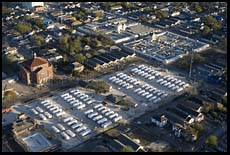
The 5D takes a single Compact Flash card, either Type I and II. Microdrives work in the camera, but operate very slowly if you are taking 14 MB RAW images. Microdrives are also more prone to failure than the solid-state CF cards and I do not recommend them.
The camera has an internal buffer memory for rapid sequence photography (17 RAWs or 60 JPEGs). The camera can capture 3 frames per second continuously.
The Canon EOS 5D does not have a built-in flash. Dedicated Canon accessory flash units mount in the hot shoe above the viewfinder and the camera is able to control flash exposure via a through-the-lens sensor. Maximum flash sync speed is 1/200th. Balancing flash and natural light is straightforward.
The 580EX is Canon's current top of the line and it usefully covers an angle as wide as a 14mm lens.
Photography in available, i.e., low, light is a pleasure with the Canon EOS 5D because the typical lenses that you'd use with this camera include the standard 50/1.4 from the film world. The following images were taken at ISO 800:
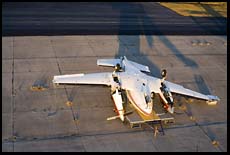
The included Lith-ion battery is adequate for a day of active photography, somewhere between 300 and 500 photos plus review. The Canon EOS 5D cannot run on disposable AA batteries. To recharge the battery you must carry a chunky travel charger that plugs directly into a wall socket.
If you take 100 pictures in quick succession, don't be alarmed when the "low battery" symbols flashes. Let the camera rest for a few minutes and the battery voltage will come back.
If you are a serious photographer, you will want to purchase and carry a backup BP-511A battery (the same battery that Canon has used in the 20D and the Gn point-and-shoot models).

I've had this EOS 5D for nearly a year and it has survived a trip through Mexico and being vibrated for two cross-country helicopter trips.
The EOS 5D is not designed for use in a continuous downpour or very dusty environment like the Canon EOS 1Ds Mark II, though it is a basically rugged and well-sealed design.
I have not experienced any camera software problems or freezes.
Here are some things that would be nice for the next version of the 5D:

Can you get a dramatically better photo with the EOS 5D and a Canon 50/1.4 compared to what you'd get with crop-sensor EOS Rebel and Sigma 30/1.4 lens? Not really. Not unless you want to blow up the image to poster size and then the 13 megapixels of the 5D will be dramatically sharper than the 8 megapixels of the Rebel.
The EOS 30D and Digital Rebel are better values. It is much cheaper for Canon to make a small sensor than a big sensor. The 5D, on the other hand, is better in the following situations:
The Canon EOS 5D has an almost identical and equally simple user interface to the cheaper Canon 20D and 30D bodies.
If you have $7000 to spend, a strong back to carry the weight, and a quick mind to take in the many displays and complex user interface, the EOS 1Ds Mark II might be better than the 5D.
The Canon EOS 5D, however, will do most professional jobs. There is a PC connector on the side for studio strobes. Without reading the manual, you can go into the custom function menu and the camera to lock up the mirror before taking a picture (then set self-timer mode on the Drive button and the camera automatically configures itself for a 2-second self-timer delay; press the button and the mirror locks up, then the shutter opens two seconds later). This is very useful for tripod and macro work.
The full-frame Canon EOS 5D is cheaper than Nikon's top-of-the-line small-sensor body. That's pretty sad, considering what a tour de force of technology the 5D's sensor is. Nikon is a small company with clever optical engineers. Canon is a massive company with the $billions to invest in building semiconductor fabrication lines. That difference really shows now that the making of cameras has come down to "How much can you invest in silicon chips?"
The Canon EOS 5D is the essential camera for everything that photographers used to do with 35mm film. It is more than good enough for most professional photojournalism applications, but still simple enough that a yuppie can get one to throw in the glovebox of his BMW SUV and take pictures at the school soccer game.

Beyond the 50/1.4, which is essential for day-to-day and low light photography, you will probably want the following standard professional zoom lenses:
Mercifully, Canon does not include a cheap zoom lens as part of a "kit" with the EOS 5D. If you insist on having a wide-to-tele zoom, the standard choice is the 24-70L, which is useful for event photography such as wedding receptions. An alternative is the 24-105/4L IS, which has the advantages of light weight and image-stabilization at the cost of one f-stop in maximum aperture, which means that the viewfinder will be only half as bright.
For taking pictures of sporting events without breaking your arm, you'll want a 300/4. (The guys you see on television might have the 600/4, but that comes in its own suitcase and costs more than a small Kia sedan.)
If you're going to take a lot of portraits, e.g., of a baby, and don't want to endure the weight of the 70-200/2.8, consider a prime Canon 100/2.0. Because this is not a zoom lens, it has many fewer individual pieces of glass inside and therefore you'll get the highest possible contrast and image quality. You lose image stabilization, but gain one f-stop in aperture so you can use higher shutter speeds and the viewfinder will be brighter.
With the 50/1.4 lens:
The 16-35/2.8L lens:
The 24-70/2.8L lens (mostly from the Robinson R44):
The 70-200/2.8L lens:
One perceived problem with professional-grade cameras is that they can't be used by novices. The 5D has a green "idiot mode" on the left control dial. The best test really is to hand the camera to a novice and see what happens.
(I flew the Jet Ranger helicopter on the left for three hours while Commander Chuck Street reported the traffic and talked me through the occasional confined or pinnacle approach; I did not fly the helicopter on the right, which is a static display at the Titan Missile Museum near Tucson, Arizona.)
Text and pictures copyright 2005-6 Philip Greenspun.